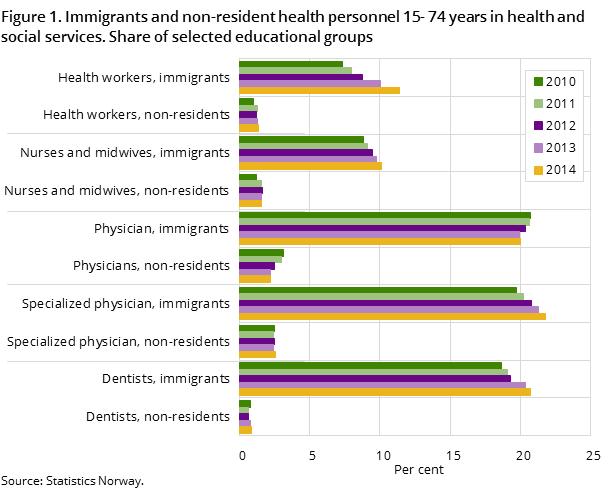Content
Published:
This is an archived release.
Increase in health care personnel
The number of employed health care personnel below the age of 67 increased by 8 100 persons from the 4th quarter of 2013 to the 4th quarter of 2014. Nearly 86 per cent of women with a health care education were employed in 2014, while the same goes for 90.2 per cent of men
| 2014 | 2013 - 2014 | 2013 | ||
|---|---|---|---|---|
| Total | Share | Per cent | Total | |
| Persons with a health care education | 436 991 | 100.0 | 2.2 | 427 769 |
| Men | 66 343 | 15.2 | 2.7 | 64 628 |
| Women | 370 648 | 84.8 | 2.1 | 363 141 |
| Employed persons with a health care education | 378 279 | 100.0 | 2.2 | 370 211 |
| Men | 59 907 | 15.8 | 2.8 | 58 279 |
| Women | 318 372 | 84.2 | 2.1 | 311 932 |
| Employed persons with a health care education in health and social services | 299 682 | 79.2 | 2.4 | 292 720 |

Among the employed health care personnel, nearly 79 per cent work within health and social services, about 6 per cent work within the educational system, 1 per cent work in temping agencies, while 11 per cent work in other industries. In certain groups of health personnel, almost all are employed outside health and social services, this particularly applies to pharmacists and opticians, who mostly work within industries related to trade in goods.
Increase in number of foreign health care personnel
Almost 34 400 immigrants and non-resident health personnel were working in health and social services in 2014. Immigrants constitute 90 per cent of this group. Nurses are the largest group, totalling 10 300 persons, while physicians were the second largest group with 5 100 persons. Physicians and nurses have increased in numbers compared to 2013. Almost 21 per cent of the nurses are Swedish.
One in ten have more than one job
Having more than one job is relatively common among health care personnel, and applied to more than one in ten in 2014. More than 21 per cent of the specialised physicians had more than one job, while 8 per cent of the nurses were in the same situation.
The average working hours for employed persons with a health care education in health and social services was 31.4 hours in the 4th quarter of 2014. This is on the same level as the preceding years.
84 per cent of health and care personnel are women
With few exceptions, women dominate most health care educations. Only six types of health care education covered by these statistics consist of more men than women. This applies to specialists in dentistry, specialised physicians, ambulance workers, chiropractors, perfusionists and orthopaedic engineers. Among medical secretaries, dental secretaries, dental nurses, health visitors and midwife educations, women totalled over 99 per cent. Among physicians under 40 years of age, the share of women was nearly 60 per cent in 2014, increasing from 55 per cent in 2008. Specialised physicians are still dominated by men.
Contact
-
Arbeidsmarked og lønn
E-mail: arbeidsmarked@ssb.no
-
Fredrik Steinrem Edelmann
E-mail: fredrik.edelmann@ssb.no
tel.: (+47) 40 90 24 60
-
Sophie Sæternes
E-mail: sophie.saeternes@ssb.no
tel.: (+47) 98 67 14 26
-
Stine Bakke
E-mail: stine.bakke@ssb.no
tel.: (+47) 91 52 62 51
